“When you take a flower in your hand and really look at it, it’s your world for the moment. I want to give that world to someone else. Most people in the city rush around so, they have no time to look at a flower. I want them to see it whether they want to or not.”~ Artist Georgia O’Keeffe
Gulls are among the birds I call “gateway birds.” They’re common and accessible. They are also visible, vocal, insistent and interactive, which makes them living portals between the wild world and the city life.
Like Georgia O’Keeffe’s flower, the gull, along with many urban birds, is overlooked and pushed aside, sometimes literally under foot on crowded sidewalks. Also like O’Keeffe’s flower, when you take the time to really look at that gull and embrace the wholeness of her — her yellow bill, her gray coverts, her ear spots or orbital rings, the white tips of her stretched wings — she becomes your world not just for the moment, but in perpetuity.
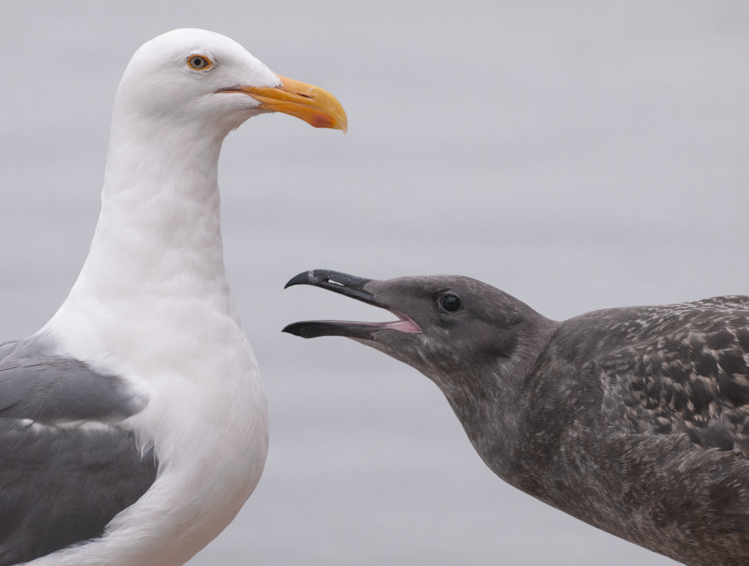
She invites you into the realm of the other … the feathered and winged other. It’s a place with a distinct language, a code of conduct, familial love, fascinating behavior, and an existence that springs miraculous from a broken eggshell on a hotel rooftop.
That’s precisely where I found myself on a recent Saturday, perched (with coffee cup) above a hotel roof in downtown Seattle — watching balls of fluff known as gull chicks, explore their urban playground.
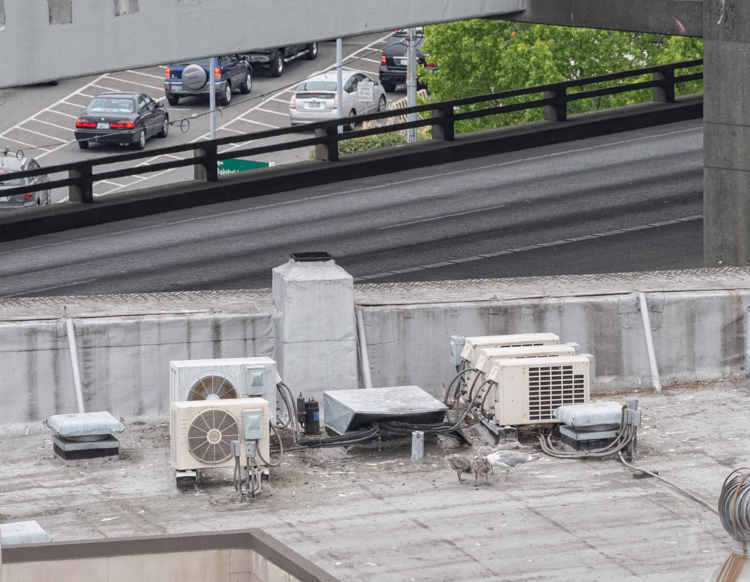
In a connection forged through this blog, a kind and thoughtful person contacted me to say she lived above a gull nesting site. She asked if I would enjoy coming by in the morning to take few photos of the growing chicks. In her words, “we have nests scattered among the air conditioning units and duct work … just across the alley, and on the roof directly alongside us, each roof with three nests. The nests range from one to three chicks, and they are amazingly adorable.”
To paraphrase Don Corleone, this generous bird watcher made me an offer I simply couldn’t refuse.
Here’s one of those amazingly adorable chicks, in a full yawn.
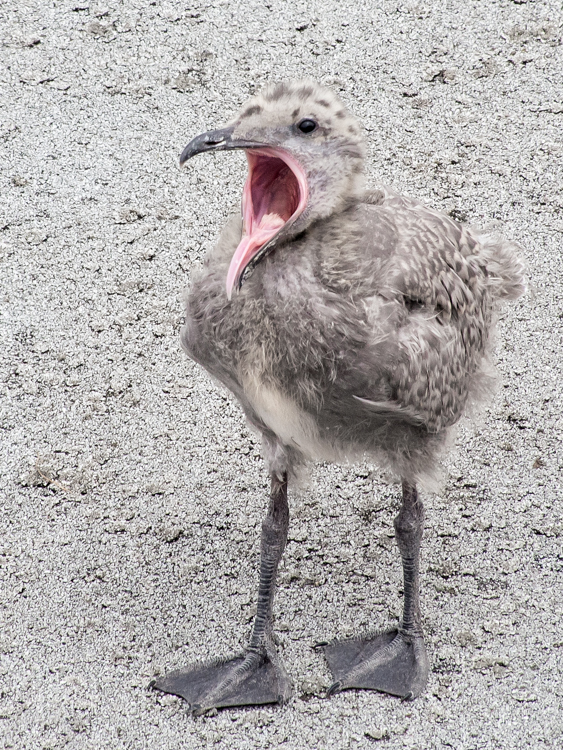
My gull ID is so spotty that even after paging repeatedly through Peterson’s Gulls of the Americas I wasn’t 100 percent sure these chicks were full-blooded Glaucous-winged Gulls. You know how complex gulls can be with their age variations and hybridized plumage. But, as the Magic 8 Ball would say, “all signs point to yes” on Glaucous-winged. One of the grown up gulls on this rooftop looked to be a “third-cycle” gull, similar in every way to an adult, but lacking the distinct white primary feather tips which stick out above the tail (primary projection).
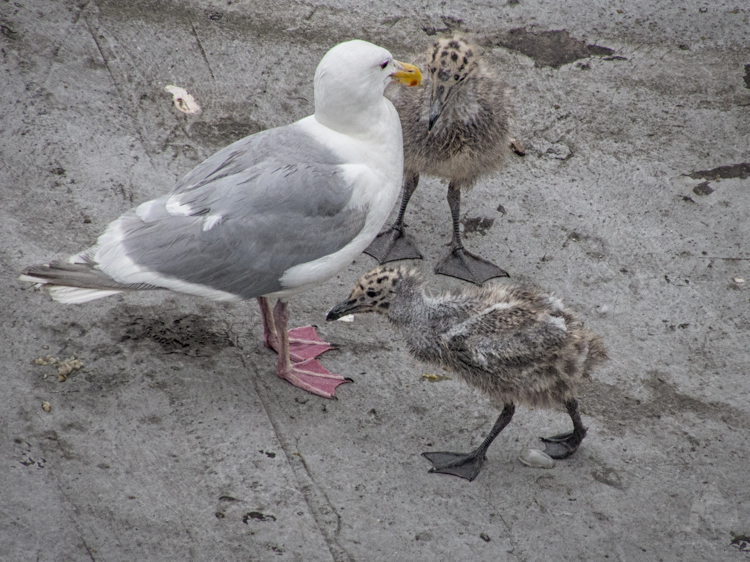
According to the Coastal Observation and Seabird Survey Team (COASST) …
… Glaucous-winged Gulls are stocky, regal-looking birds with light grey backs and wings complementing a bright white head, breast and belly. Adult birds even sport flashes of color with their red-spotted yellow bills, pink feet, and dark eyes with pink eye-rings.
No such luck identifying juvenile glaucous-wings. Unless you are a gull expert, first year and sub-adult gulls are nearly impossible to distinguish at the species level. Therefore, COASST lumps all of these mottled brown adolescents into one category, the LIGU (Large Immature GUlls).
That means that once these cute, fluffy chicks fledge and grow into their various cycles of plumage, they’ll be similarly lumped as LIGUs until they develop their distinct, stocky and regal ID marks.
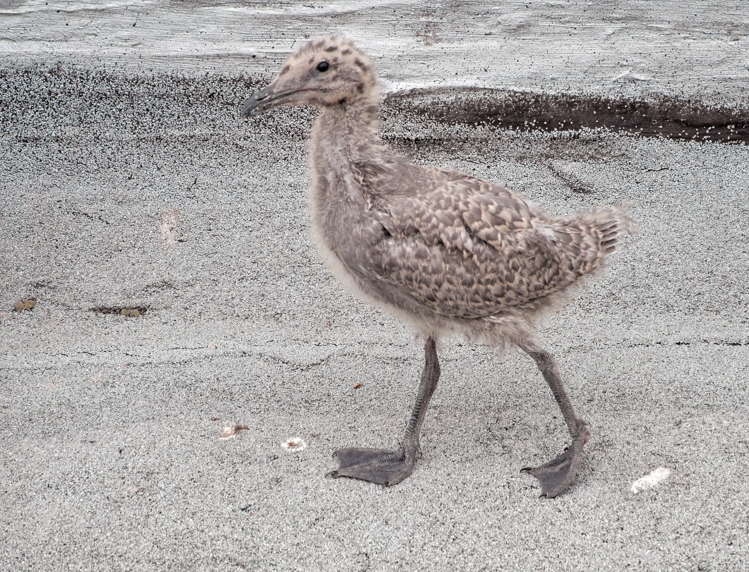
Glaucous-winged Gulls are highly adaptable which allows them to survive on a variety of forage and foodstuffs. They’ll eat fish and shellfish, some carrion, and also human food scraps. On the rooftop, one parent regurgitated food for her young which looked to be mussels.
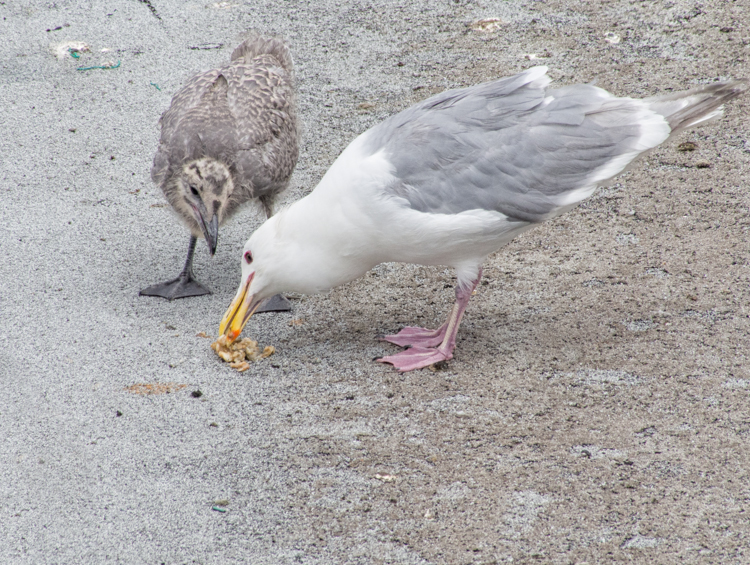
Another parent had what looked like a marine worm. And there was also a discarded chicken bone which I’m assuming came from a fast food score.
The colors and textures of the chicks blended so well with their industrial backdrop, you’d almost have to know they were there to actually spot them. I couldn’t have asked for a setting that better matched my urban wildlife aesthetic.
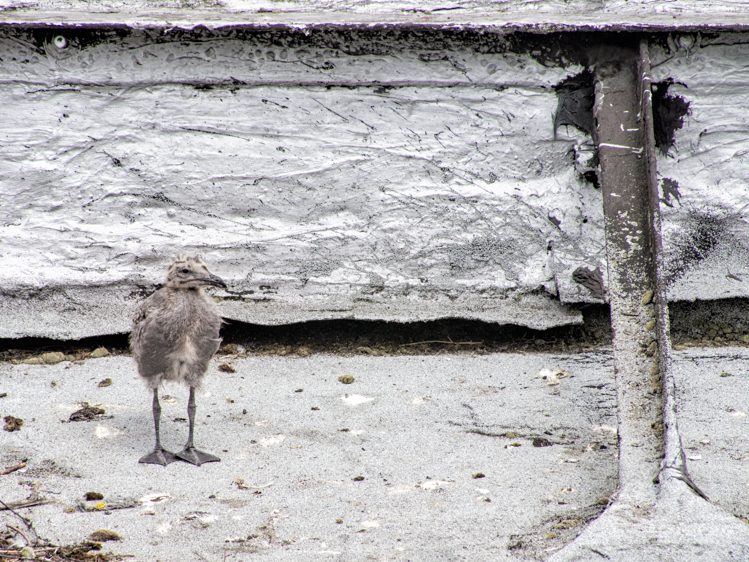
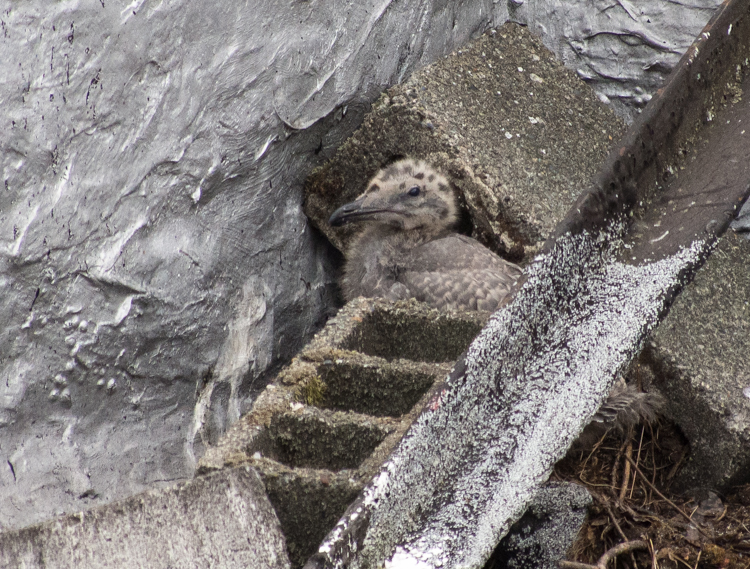
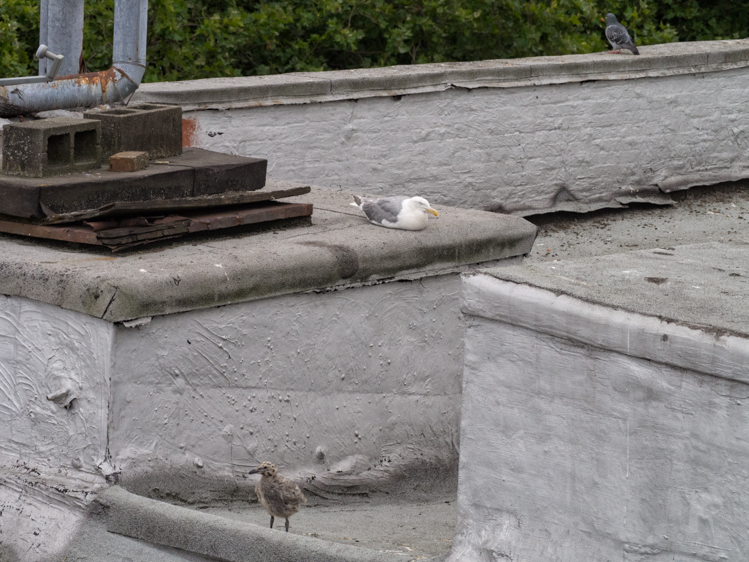
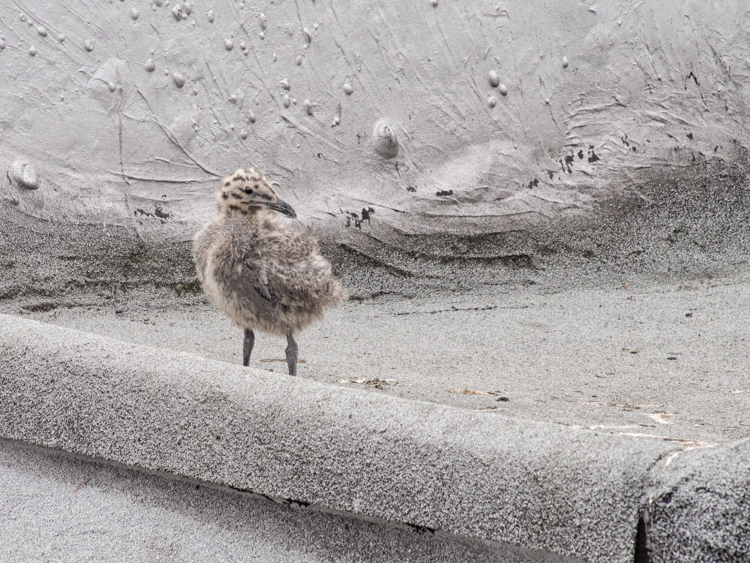
The gulls incubate 28 days or so before hatching these spotted chicks who are semi-precocial — able to walk within a day or two after leaving their eggshells behind.
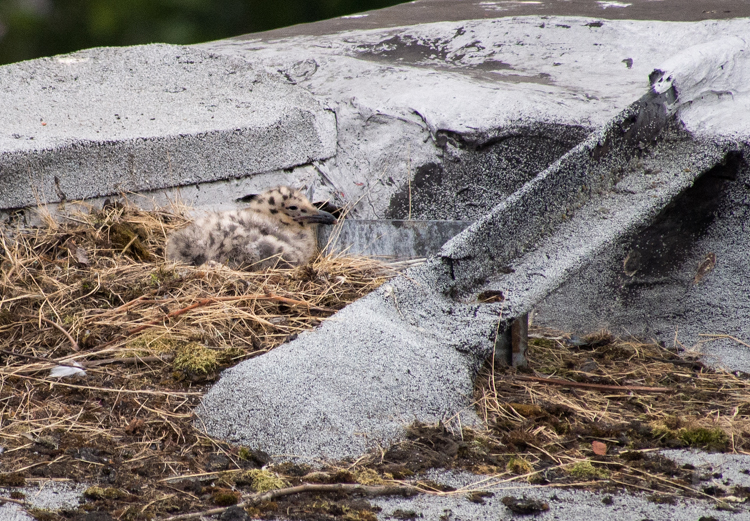
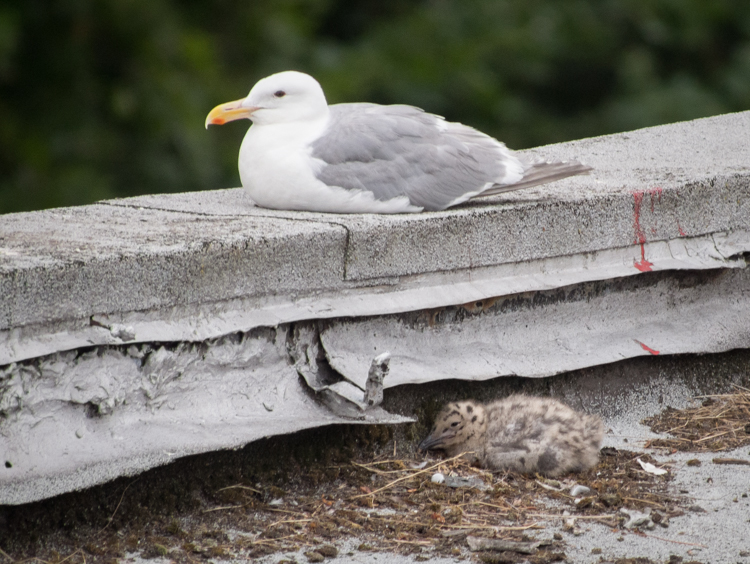
Both parents feed the chicks as they grow into their juvenile plumage and flight feathers, at which point they’ll practice flapping and hopping and getting lift, using the flat rooftop expanse as a runway. They’ll properly fledge 50 to 60 days after their hatch date, joining the festival of LIGUs loafing on the Seattle shoreline.
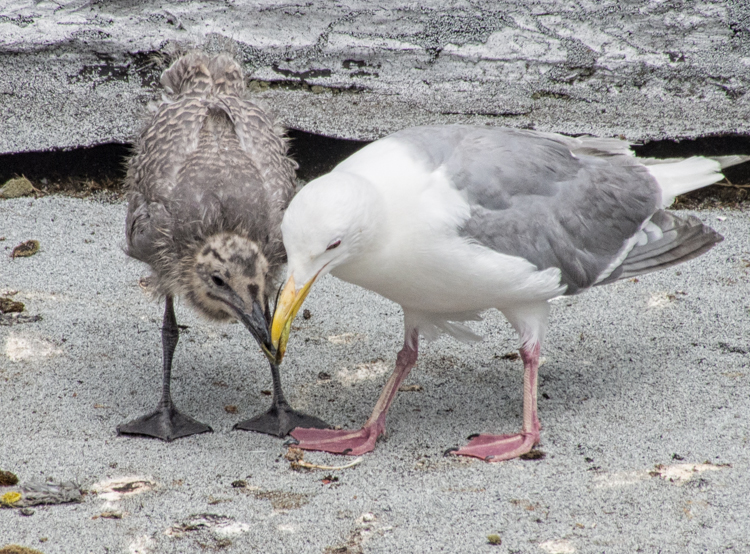
When Georgia O’Keeffe says about her flower, “I want them to see it whether they want to or not,” she describes my sentiments about urban wildlife: I want people to see them, whether they want to or not. I want people who normally walk by or shoo them or call them “rats with wings,” to really look at these winged marvels — to bear witness to their inherent value — to their unique entitlement on this planet as gulls, or crows or pigeons.
When I photograph urban wild animals, I hope to freeze some of that marvelousness inside a frame that illuminates for others their right to coexistence, kindness and consideration. I feel this especially for the urban ones since they are survivors in our blight — the stalwart emissaries for their kind. They are the birds who promise a gateway from the frazzled detachment that overtakes urban existence, to genuine connectivity between humans and their nature … all in the context of pavement, car horns, soot and air conditioning vents.
==> Thank you, L & S, for this privileged view into the world of Seattle’s rooftop gulls!
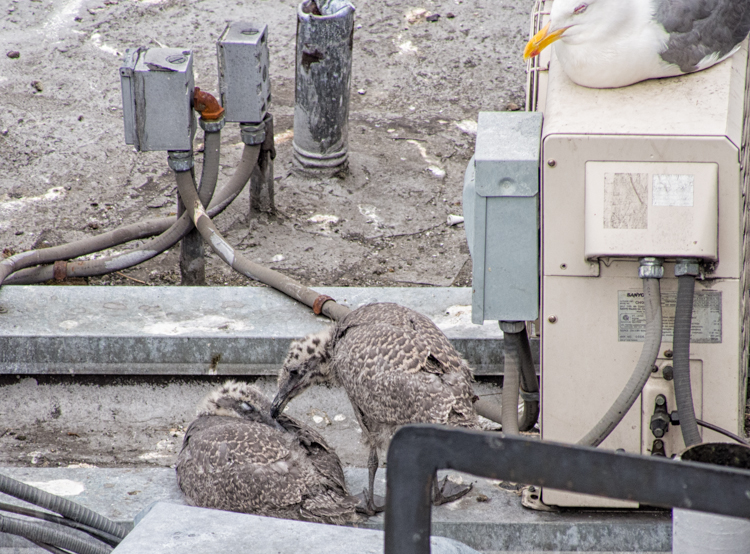
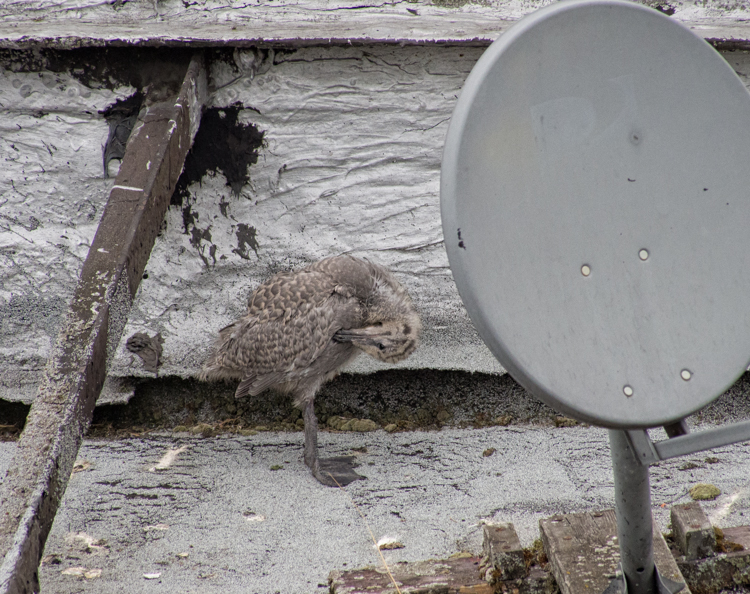
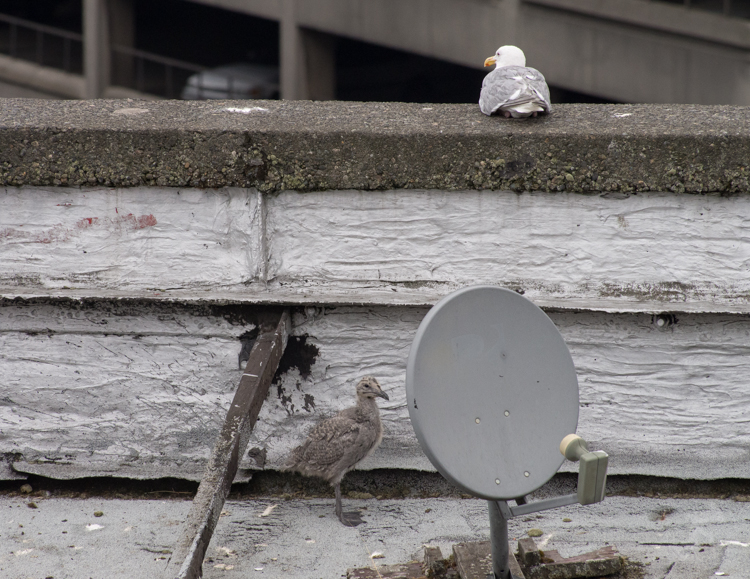
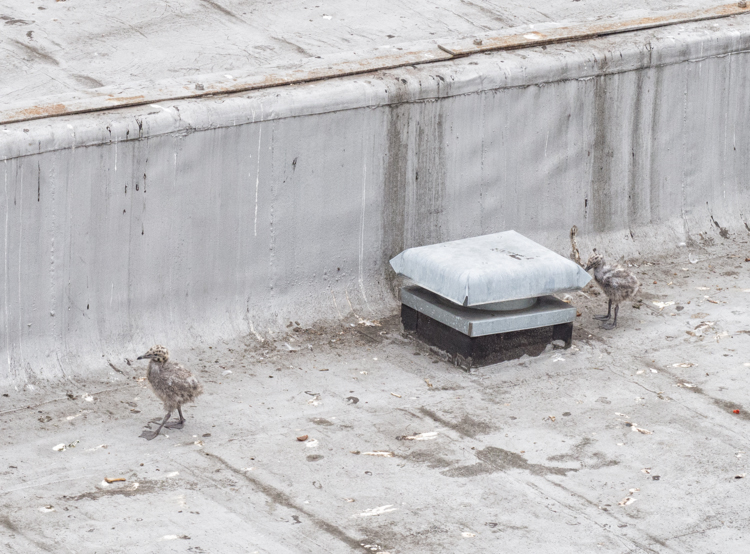
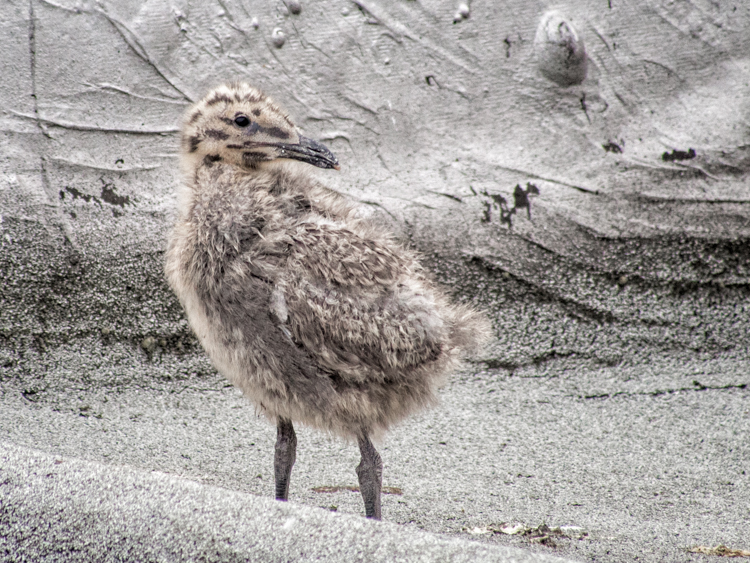
—————————-
Gull chicks photographed in Seattle with my Olympus OM-D + Lumix 100-300mm. Most images were shot at ISO800 — until a bit later in the morning when the sun peered through overcast. Some adjustments exceed my standard raw file edits to compensate for the under-exposed conditions. Those include enhanced levels, exposure, color correction.

Ingrid, this is such a wonderful post. I know many people who don’t like gulls or won’t stop to really look at them or raise their lens towards them. Personally I find them to be fascinating and lovely birds.
I love these images of them in the urban setting, it is really quite touching to me because they have learned to adapt to the pressures humans are placing upon them. I’ve had to adapt a lot in my life, perhaps that is why I feel a connection to gulls.
Thanks for sharing these
Mia, this is my third attempt at responding … my comments are disappearing from my own blog. I’m attributing it to our mutual hosting outages today.
I’m attributing it to our mutual hosting outages today.
What I *tried* to say before being deleted was first — thank you kindly. I relate also to your appreciation for adaptation. Second, I am in awe every time I walk city streets and see how wild animals manage our existence. I see pigeons navigating the wind tunnels between sky scrapers … I recently saw Tree Swallows fledging from a tree in a shopping mall plaza … and the gulls, ubiquitous, social, intelligent and entertaining.
I often wonder how people just can’t see what I see — how they are not at least occasionally amazed that we share this terrain with magical, flying beings. That’s what Hugh and I always say — that the flight itself should be a marvel everyday. Their aerobatics defy all human aviation innovation. Maybe we’re just too many years away now from Rachel Carson’s “Silent Spring” to appreciate what our world would be without their feathers and songs coloring our urban landscapes.
I worry that we are not all that far away from a “Silent Spring”.
I know, Mia — especially when you consider the pollinator and bee crisis in conjunction with everything else. Right now, I just can’t see a viable way for all of us to coexist with human population expansion into the exponential. But, maybe I’m too short-sighted to take into account innovative ideas of the future. There are definitely interesting developments in the pipeline which promote global food solutions that are much less land-intensive. If people could embrace those, and move away from the most habitat-intensive operations (cattle grazing, etc) that’s one thing that could dramatically alter the landscape for wildlife.
Ingrid, these photos are more lovely than I could have hoped for, and with such a wonderful and welcoming feature to accompany them! The little ones are starting to get their flying gear on; we look forward to hosting you again so you can capture their first airborne moments… All the best, L&S
Louise … so much appreciation from this end! It would be great to see these little ones evolve into flighted gulls — with fingers crossed they all fly well, with perfect headwinds and tailwinds.
It’s amazing Ingrid how you’ve been able to witness this event in such urban setting. I fear for them, in the sense that I hope the air conditioning machinery doesn’t harm them in any way, but I suppose gulls have developed a good immune response in highly urbanized and polluted areas already (like pigeons have). I have to admit tbat for me it’s difficult to see birds in this situation; yet I see pigeons doing the same thing around where I live. Our Caribbean Grackle has nested in the crevices of stop lights. It’s fascinating to see how some species simply adapt to our cities and way of life.
Maria … thanks, again, to the kind people who let me into their loft to do so! And, yes — it’s entirely reasonable to be concerned about those urban trappings. Check out the video I just posted about two such rescues. I understand your feelings about seeing birds in these situations. It speaks to what we’ve done to our ecology, in so many ways. I tend to see it as a victory for the animals when they manage to find ways into our cement fortresses to actually thrive and reproduce. Not ideal from a nature standpoint, but it’s a testament to their genuine adaptability in the face of our carelessness about them.
What gets to me is how some people continue to consider these animals as invaders of human territories; when all these animals are doing is rightfully claiming their territory. Racoons, snakes, even coyotes, among others, infiltrate cities at night and send their message loud and clear to deafened anti-environmentalists who all they can think of is how to exploit the next oceanic drilling oil site or make money out of more housing expansion projects at the cost of the environment.
Love the post. And it is good to remember that there really is no clear dividing line between city life and the natural country life. Birds and other creatures will move in whereever they can and in doing so, they bring nature to us where we live.
Glenn, to borrow that now-old cliché — if you build it, they will come. I think about Heron’s Head Park where you take frequent walks. By Seattle standards, it’s a large swath of reclaimed waterfront. On San Francisco Bay, it’s one of the smaller parks, but what an amazing diversity it hosts. I was documenting the progress of a 15-acre parcel up here in the Northwest, and the bird species count was close to 200, after various habitat measures were put in place. If we humans could just get out of the way a little bit more …
I am certain I won’t ever look at urban roof tops the same again! Who knew such speckled and feathered wonders would nest and grow up there among the ducts, vents and a/c units? What a wonder!
Years ago when I lived in a rural area I was responsible for getting my trash to the dump. Best part of it was observing and listening to the gulls. Since then the only time I get to see them is if we go to “the beach” or out on the boat. One thing I do find perplexing though and maybe you know why it’s so… We could be off shore by 30 miles – If we throw scraps into the water one gull will show up in no time. Then followed by dozens… How on earth do they do that? :/
Love your beautiful photos! Can’t wait to see the ones you share during the chicks maiden voyage into the sky!
Bea, I’m not sure if there are definitive answers on how gulls and other birds communicate this information so readily, but they do have complex interactivity. I see it with pelicans, too, on the California coast. It’s amazing how they all seem to know where the fish are. They leave the harbor in the morning and head out to meet up with other pelicans around bait balls, herring runs, etc. It’s one of the reasons I find birds endlessly fascinating — and why their social circles become much more interesting when people dispense with anthropocentric ideas of intelligence. I’m really curious about your question and will do some reading to see if I find anything more illuminating.
I absolutely LOVE this post Ingrid. Your photographs are excellent (of course) blending the beauty of the birds with the stark rooftop/city landscape, like the shot with the cars in the background and the mom feeding the chicks in the fore. But it’s the wonderful way you weave the story and make us see and feel your oneness with nature that really inspires people. You have a special gift and I, for one, am ecstatic that you choose to share your magic with us. My favorite photograph in this piece, if forced to choose one, would be the “Gull Chick in Rooftop Nest.”
Larry, what a kind comment — you made my day(s), thank you! There are times I’m frustrated by the inability to truly relate what I know we all feel when we’re out there. When I manage to do on any level, that makes me happy. I truly believe that education is the solution to so many human/wildlife interaction issues. And I can’t help but think that it’s through the observation of these life cycles that people come to care more. When you have a view into what it takes for them to survive and nurture their young to adulthood, it becomes impossible to take those individuals for granted.
Another beautiful post, Ingrid. Your writing is every bit as amazing as your photography.
One thing I love doing while I’m out and about is spotting birds nesting in eaves. I forget everything else when this happens because they completely capture my attention. I just want to stand there all day and look. I am both elated and sad, like I was reading this post.
Erin, thank you too. I know what you mean about the eaves … and the mixed feelings. I get those same types of pangs. It’s a wonder they can adapt to our settings at all. There’s a reason many nature photographers prefer to photograph wildlife in natural habitat surroundings. But, I’ve always rooted for the underdog. Life is tough for an urban bird!
Weighing in late — and am so glad I didn’t pass up this post!
Like Larry, I LOVE everything about it, from the ugly roof tops to the adorable fluff balls to the stately, sleek, solicitous parents. Your description of the gulls as “living portals between the wild world and the city life” is spot-on, Ingrid, as are all the adjectives you selected to describe them: visible, vocal, insistent, interactive, and, in one of your comments, ubiquitous, social, intelligent, entertaining. Yes, indeed!
I’ve been conscious of gulls ever since growing up across the street from a beach smack dab on Long Island Sound, but their lively antics and raucous chatter never “grabbed” me like they do now.
Funnily enough, the last time I encountered a flock of gulls was at a little picnic area facing Tampa Bay! I was with Bea! Remember that, my friend? We brought a picnic lunch (I on the plane, Bea in her car) and met at the airport, then drove to this quiet spot (uninhabited because it was the middle of a school day, as I recall). As we finished our sandwiches and chips, I tossed some crumbs in the air, and out of the blue came a sole gull. More food flinging brought other gulls out from who-knows-where, and before long, we were surrounded by a hungry mob. We ran out of edibles just as someone pulled up in an SUV, parked, got out, and reached into a big bag filled with bread crumbs. The gulls recognized this “regular” feeder and made a bird-line for him. What fun we had watching them dive and swoop and float and feast!
The comments always enhance your posts, Ingrid. The ones above were a pleasure to read — and easy to agree with, now that I’ve opened my heart to all the marvelous creatures in my daily path! What a barren life I led before I became blissfully aware of animals everywhere!
CQ, you are always so generous in your commentary — not just with a kind compliment, but in offering a piece of your thought process and experience.
When you mention being grabbed by the gulls’ lively chatter, I have to say that although I’ve always liked and admired gulls — my parents encouraged bird feeding, one of my favorite activities as a kid — it wasn’t until we moved up to Seattle that I became aware of their multitudes of sounds and calls. There are so many gulls here. And there’s one call of the Glaucous-winged Gull that’s become my particular favorite. They often speak it when asking people for food and to me it sounds like “ha, ha, ha.” It’s a low murmur you can hear at the very beginning of this sound clip: https://www.allaboutbirds.org/guide/Glaucous-winged_Gull/sounds
There are also a lot of Mew Gulls here in the winter, and their calls are like mews. There’s a sound link at this page from Seattle Audubon: https://www.birdweb.org/birdweb/bird/mew_gull?tab=4
As far as being blissfully aware, I do relate, too. I didn’t fully understand them and I’m still learning about them. But in terms of what I do know, I admire them, I’m fascinated by them, I am amused by their behaviors and their humor and mischief, and their amazing intelligence that allows them to navigate their often dangerous worlds.
Oh, wow, the Glaucous-wingeds sound like the feisty gulls I know from my youth; the mews sound just like, well, kittens. Thanks for sharing the sounds, Ingrid. In fact, you’ve spoiled me, and now I expect that you’ll link to the sound of each and every bird you write about from now on!
Love love love this post. Thank you! As always, you are spot on, with such eloquent words and gorgeous photos. Until I met a gull in person, I respected them as fellow living beings but wasn’t personally fond of them. They seemed a bit mean and obnoxious (and they are officially kleptovores). When I rescued a fishing-line entangled gull that, after bad outcomes with wildlife rescue, I decided to try and save myself, I named him Einstein he was so smart. And he was incredible (of course) in all kinds of ways. There is so much to each one, as with us all. Again and always, Ingrid- thank you!
I’m just now getting to this post, and it’s a particular treasure since I don’t think I’ve ever seen gull chicks before I also enjoy the photo titles (“Chick Yawn”)
I also enjoy the photo titles (“Chick Yawn”) 